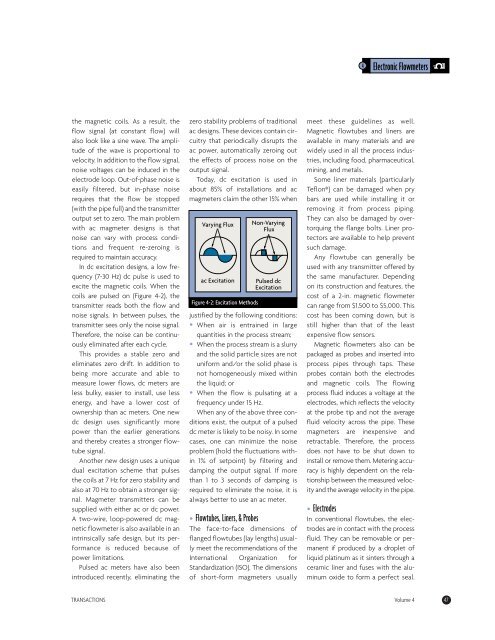flow and level measurement - Omega Engineering
flow and level measurement - Omega Engineering
flow and level measurement - Omega Engineering
Create successful ePaper yourself
Turn your PDF publications into a flip-book with our unique Google optimized e-Paper software.
the magnetic coils. As a result, the<br />
<strong>flow</strong> signal (at constant <strong>flow</strong>) will<br />
also look like a sine wave. The amplitude<br />
of the wave is proportional to<br />
velocity. In addition to the <strong>flow</strong> signal,<br />
noise voltages can be induced in the<br />
electrode loop. Out-of-phase noise is<br />
easily filtered, but in-phase noise<br />
requires that the <strong>flow</strong> be stopped<br />
(with the pipe full) <strong>and</strong> the transmitter<br />
output set to zero. The main problem<br />
with ac magmeter designs is that<br />
noise can vary with process conditions<br />
<strong>and</strong> frequent re-zeroing is<br />
required to maintain accuracy.<br />
In dc excitation designs, a low frequency<br />
(7-30 Hz) dc pulse is used to<br />
excite the magnetic coils. When the<br />
coils are pulsed on (Figure 4-2), the<br />
transmitter reads both the <strong>flow</strong> <strong>and</strong><br />
noise signals. In between pulses, the<br />
transmitter sees only the noise signal.<br />
Therefore, the noise can be continuously<br />
eliminated after each cycle.<br />
This provides a stable zero <strong>and</strong><br />
eliminates zero drift. In addition to<br />
being more accurate <strong>and</strong> able to<br />
measure lower <strong>flow</strong>s, dc meters are<br />
less bulky, easier to install, use less<br />
energy, <strong>and</strong> have a lower cost of<br />
ownership than ac meters. One new<br />
dc design uses significantly more<br />
power than the earlier generations<br />
<strong>and</strong> thereby creates a stronger <strong>flow</strong>tube<br />
signal.<br />
Another new design uses a unique<br />
dual excitation scheme that pulses<br />
the coils at 7 Hz for zero stability <strong>and</strong><br />
also at 70 Hz to obtain a stronger signal.<br />
Magmeter transmitters can be<br />
supplied with either ac or dc power.<br />
A two-wire, loop-powered dc magnetic<br />
<strong>flow</strong>meter is also available in an<br />
intrinsically safe design, but its performance<br />
is reduced because of<br />
power limitations.<br />
Pulsed ac meters have also been<br />
introduced recently, eliminating the<br />
zero stability problems of traditional<br />
ac designs. These devices contain circuitry<br />
that periodically disrupts the<br />
ac power, automatically zeroing out<br />
the effects of process noise on the<br />
output signal.<br />
Today, dc excitation is used in<br />
about 85% of installations <strong>and</strong> ac<br />
magmeters claim the other 15% when<br />
Varying Flux<br />
Figure 4-2: Excitation Methods<br />
Non-Varying<br />
Flux<br />
ac Excitation Pulsed dc<br />
Excitation<br />
justified by the following conditions:<br />
• When air is entrained in large<br />
quantities in the process stream;<br />
• When the process stream is a slurry<br />
<strong>and</strong> the solid particle sizes are not<br />
uniform <strong>and</strong>/or the solid phase is<br />
not homogeneously mixed within<br />
the liquid; or<br />
• When the <strong>flow</strong> is pulsating at a<br />
frequency under 15 Hz.<br />
When any of the above three conditions<br />
exist, the output of a pulsed<br />
dc meter is likely to be noisy. In some<br />
cases, one can minimize the noise<br />
problem (hold the fluctuations within<br />
1% of setpoint) by filtering <strong>and</strong><br />
damping the output signal. If more<br />
than 1 to 3 seconds of damping is<br />
required to eliminate the noise, it is<br />
always better to use an ac meter.<br />
• Flowtubes, Liners, & Probes<br />
The face-to-face dimensions of<br />
flanged <strong>flow</strong>tubes (lay lengths) usually<br />
meet the recommendations of the<br />
International Organization for<br />
St<strong>and</strong>ardization (ISO). The dimensions<br />
of short-form magmeters usually<br />
4 Electronic Flowmeters<br />
meet these guidelines as well.<br />
Magnetic <strong>flow</strong>tubes <strong>and</strong> liners are<br />
available in many materials <strong>and</strong> are<br />
widely used in all the process industries,<br />
including food, pharmaceutical,<br />
mining, <strong>and</strong> metals.<br />
Some liner materials (particularly<br />
Teflon®) can be damaged when pry<br />
bars are used while installing it or<br />
removing it from process piping.<br />
They can also be damaged by overtorquing<br />
the flange bolts. Liner protectors<br />
are available to help prevent<br />
such damage.<br />
Any <strong>flow</strong>tube can generally be<br />
used with any transmitter offered by<br />
the same manufacturer. Depending<br />
on its construction <strong>and</strong> features, the<br />
cost of a 2-in. magnetic <strong>flow</strong>meter<br />
can range from $1,500 to $5,000. This<br />
cost has been coming down, but is<br />
still higher than that of the least<br />
expensive <strong>flow</strong> sensors.<br />
Magnetic <strong>flow</strong>meters also can be<br />
packaged as probes <strong>and</strong> inserted into<br />
process pipes through taps. These<br />
probes contain both the electrodes<br />
<strong>and</strong> magnetic coils. The <strong>flow</strong>ing<br />
process fluid induces a voltage at the<br />
electrodes, which reflects the velocity<br />
at the probe tip <strong>and</strong> not the average<br />
fluid velocity across the pipe. These<br />
magmeters are inexpensive <strong>and</strong><br />
retractable. Therefore, the process<br />
does not have to be shut down to<br />
install or remove them. Metering accuracy<br />
is highly dependent on the relationship<br />
between the measured velocity<br />
<strong>and</strong> the average velocity in the pipe.<br />
• Electrodes<br />
In conventional <strong>flow</strong>tubes, the electrodes<br />
are in contact with the process<br />
fluid. They can be removable or permanent<br />
if produced by a droplet of<br />
liquid platinum as it sinters through a<br />
ceramic liner <strong>and</strong> fuses with the aluminum<br />
oxide to form a perfect seal.<br />
TRANSACTIONS Volume 4 47

















